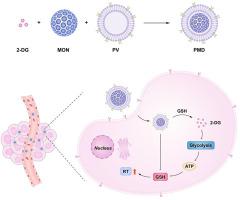Journal of Pharmaceutical Analysis ( IF 8.8 ) Pub Date : 2024-01-17 , DOI: 10.1016/j.jpha.2024.01.003 Xiaopeng Li , Yang Zhong , Pengyuan Qi , Daoming Zhu , Chenglong Sun , Nan Wei , Yang Zhang , Zhanggui Wang

|
Radiotherapy (RT) is one of the most common treatments for cancer. However, intracellular glutathione (GSH) plays a key role in protecting cancer from radiation damage. Herein, we have developed a platelet membrane biomimetic nanomedicine (PMD) that induces double GSH consumption to enhance tumor radioimmunotherapy. This biomimetic nanomedicine consists of an external platelet membrane and internal organic mesoporous silica nanoparticles (MON) loaded with 2-deoxy-D-glucose (2-DG). Thanks to the tumor-targeting ability of the platelet membranes, PMD can target and aggregate to the tumor site, which is internalized by tumor cells. Within tumor cells overexpressing GSH, MON reacts with GSH to degrade and release 2-DG. This step initially depletes the intracellular GSH content. The subsequent release of 2-DG inhibits glycolysis and adenosine triphosphate (ATP) production, ultimately leading to secondary GSH consumption. This nanodrug combines dual GSH depletion, starvation therapy, and RT to promote immunogenic cell death and stimulate the systemic immune response. In the bilateral tumor model in vivo, distal tumor growth was also well suppressed. The proportion of mature dendritic cells (DC) and CD8+T cells in the mice was increased. This indicates that PMD can promote anti-tumor radioimmunotherapy and has good prospects for clinical application.
中文翻译:

血小板膜仿生纳米药物诱导双谷胱甘肽消耗以增强癌症放射免疫治疗
放射治疗 (RT) 是最常见的癌症治疗方法之一。然而,细胞内谷胱甘肽(GSH)在保护癌症免受辐射损伤方面发挥着关键作用。在此,我们开发了一种血小板膜仿生纳米药物(PMD),可诱导双倍 GSH 消耗以增强肿瘤放射免疫治疗。这种仿生纳米药物由外部血小板膜和内部负载 2-脱氧-D-葡萄糖 (2-DG) 的有机介孔二氧化硅纳米粒子 (MON) 组成。得益于血小板膜的肿瘤靶向能力,PMD可以靶向并聚集到肿瘤部位,并被肿瘤细胞内化。在过度表达 GSH 的肿瘤细胞内,MON 与 GSH 发生反应,降解并释放 2-DG。此步骤最初会耗尽细胞内的 GSH 含量。随后释放的 2-DG 会抑制糖酵解和三磷酸腺苷 (ATP) 的产生,最终导致二次 GSH 消耗。这种纳米药物结合了双重 GSH 消耗、饥饿疗法和 RT,促进免疫原性细胞死亡并刺激全身免疫反应。在体内双侧肿瘤模型中,远端肿瘤的生长也得到了很好的抑制。小鼠体内成熟树突状细胞(DC)和CD8 + T细胞的比例增加。这表明PMD可以促进抗肿瘤放射免疫治疗,具有良好的临床应用前景。



























 京公网安备 11010802027423号
京公网安备 11010802027423号